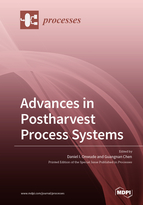Advances in Postharvest Process Systems
A special issue of Processes (ISSN 2227-9717). This special issue belongs to the section "Food Process Engineering".
Deadline for manuscript submissions: closed (16 May 2021) | Viewed by 43827
Special Issue Editors
Interests: computational fluid dynamic; mechanistic modeling; digital twins; drying technology; postharvest technology; agricultural engineering; food preservation and processing
Special Issues, Collections and Topics in MDPI journals
Interests: renewable energy and bio-energy; life-cycle assessment; sustainable agriculture and farming systems; crop postharvest and drying systems
Special Issues, Collections and Topics in MDPI journals
Special Issue Information
Dear Colleagues,
It has been widely recognized that one of the biggest challenges in the agricultural production value chain is the issue of postharvest handling and processing of agricultural products. It is estimated that 25-30% of global food produced is lost during the postharvest value chain, mainly due to fallible chain management (especially during sorting, bulk storage, packaging, and transportation), spoilage, and pest infestation. Several systems and processes have been developed to reduce the postharvest losses of agricultural products during postharvest cooling, transport, and storage operations. For example, the use of "cold " handling and storage systems to prevent perishable food losses; the thermal and non-thermal processing of harvested agricultural products to reduce spoilage and enhance shelf-life; and the drying of agricultural products to also reduce spoilage, increase shelf-life, and reduce the bulk weight of products during transportation. Nevertheless, most of the systems developed are yet to be fully commercialized. This is a result of an inadequate understanding of the complex nature of different agricultural products, understanding of the physics behind different phenomena that occur during different postharvest processes (e.g drying, cooling...etc), and the upscaling of developed process systems. For instance, a lot of strongly coupled phenomena take place during cooling and dehydration of agricultural products, including (1) heat and mass transport inside the material, (2) their exchange with the airflow in the environment, (3) microstructural damages, (4) shrinkage, and (5) reduction of nutritional density. These coupled physiochemical processes make it challenging to understand and optimize the relation between process parameters and final product properties and structure. Therefore, the successful design of a cooling, packaging, storage, transport and drying processes of fresh food requires linking materials science, fluid dynamics, mechanical deformation, food chemistry, and process control.
This Special Issue on “ Advances in Postharvest Process Systems” focusses on the latest research and development in this area. We target specifically the development and application of novel and sustainable postharvest process technologies as well as how modeling can help advance innovative processes or technologies by providing insight for process optimization. Contributions to cover materials such as meats, fruits and vegetables, grains, foods, and fibres are most welcome. In addition, review papers providing critical overviews of state-of-the-art developments on postharvest engineering research are welcomed. Topics include, but are not limited to:
- Advances in drying technologies and modeling thereof (multiscale, multiphysics, multiphase);
- Advances in food system and postharvest value chain management and modeling thereof (multiscale, multiphysics, multiphase);
- Advances in packaging technologies
- Emerging cold chain processing technologies and modeling thereof
- Emerging storage technologies and modeling thereof
- Emerging transport technologies and modeling thereof
- New approaches on improving models and model accuracy (e.g. coupling of quality models, advanced material property models)
- Model validation at different scales (e.g micro scales, macro scales), using advanced monitoring methods
- Product separation
- Intelligent process control using computational engineering
- Scale-up studies from laboratory to process plant level (simulation and experimental driven)
- Application of digital twins in cold-chain, storage, and drying systems
- Environmental impact assessment.
We aim to have a rapid review process to provide a channel for the timely dissemination of fresh, and impactful manuscripts. Apart from providing research on recent trends in postharvest engineering, this research series is envisioned to catalyzed simulation research on different unit operations in the postharvest value chain to better understand process modeling and optimization towards a sustainable system
Dr. Daniel I. Onwude
Assoc. Prof. Guangnan Chen
Guest Editors
Manuscript Submission Information
Manuscripts should be submitted online at www.mdpi.com by registering and logging in to this website. Once you are registered, click here to go to the submission form. Manuscripts can be submitted until the deadline. All submissions that pass pre-check are peer-reviewed. Accepted papers will be published continuously in the journal (as soon as accepted) and will be listed together on the special issue website. Research articles, review articles as well as short communications are invited. For planned papers, a title and short abstract (about 100 words) can be sent to the Editorial Office for announcement on this website.
Submitted manuscripts should not have been published previously, nor be under consideration for publication elsewhere (except conference proceedings papers). All manuscripts are thoroughly refereed through a single-blind peer-review process. A guide for authors and other relevant information for submission of manuscripts is available on the Instructions for Authors page. Processes is an international peer-reviewed open access monthly journal published by MDPI.
Please visit the Instructions for Authors page before submitting a manuscript. The Article Processing Charge (APC) for publication in this open access journal is 2400 CHF (Swiss Francs). Submitted papers should be well formatted and use good English. Authors may use MDPI's English editing service prior to publication or during author revisions.
Keywords
- Postharvest engineering
- Computational engineering
- Fruits and vegetables
- Food
- Agricultural materials
- Food security
- Mechanistic modeling
- Multiphase and multiphysics modeling
- CFD and FEM
- Packaging technology







